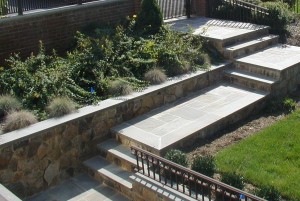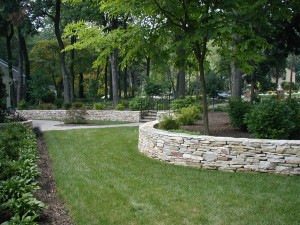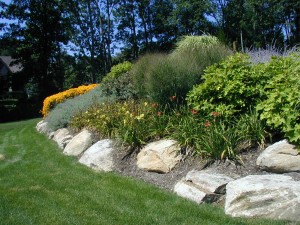
Stone-faced masonry wall - design Thomas Biro, landscape architect
What are retaining walls?
Retaining walls are structures that hold back (retain) land behind it in order to change the topography of that land. There are hundreds of varieties of retaining walls, but most can be classified as one of three types; gravity, cantilever and counterfort. For this discussion we will be talking about smaller landscape walls (4′ and under) used in residences. These are generally gravity type walls.
Why use retaining walls?
- You are looking to improve the outside of your home and make it more usable but their is no flat land
- You are getting water in your basement every time it rains because of the slope of your land.
- You want to add some vertical interest or structure to your landscape.
All these are good reasons to add retaining walls to your landscape project.
Slopes
Many people have called me up to prepare a landscape plans for them and then warn me “But I have a difficult site.” Only to go there and see that they have a hill in their backyard and want a pool, a patio or an outdoor kitchen area. I tell them “Design is Problem Solving”. The slopes and uneven terrain may be a design challenge but it makes for a unique and interesting landscape in the end.
Drainage
Poor drainage can cause a variety of problems; from minor problems such soggy spots around your property to major problems like water in your basement. Many drainage problems can be solved with simple grading and the use of retaining walls. However, if you are getting water in your basement it can also be coming in because of gutter and leader problems, cracked foundations, or high water tables.
Structure
Retaining wall can be a beautiful addition to your landscape. The many different materials used for walls (such as stone, brick, stucco, metal) create a distinct style which can set the tone for the rest of the yard. Retaining walls can be used as seat walls and they can be terraced for planting beds.
Some Retaining wall types

Dry-laid Western Sunset Sandstone wall - design by Thomas Biro, landscape architect.
Dry-laid Stone Walls
Dry-laid stone walls are a versatile wall to use in the landscape. You can choose from a variety of sizes, shapes, colors and types. The walls are constructed without the use of mortar which means the weight of the stones alone hold them together. They are built directly on the ground so that it is important to test the soil beneath the area of the wall prior to construction. Dry-laid walls allow for movement during times of freezing and thawing in temperate climates. No concrete footings are required for these walls which usually means they cost less than masonry walls. Another important detail when building both dry-laid and mortared walls is to provide drainage behind the wall so that pressure doesn’t eventually push the wall over. This is usually accomplished with gravel and perforated pipe.

Boulder Retaining Wall - design by Thomas Biro, landscape architect
Boulder Walls
Maybe the least expensive way to retain a slope and one of the most natural-looking. Again the selection boulder types is vast. Placement of the boulders can be tricky. It is important that it looks like it belongs there and is set naturally into the slope. Plantings set amongst the rocks soften the wall and with the right choice of blooms can create a spectacular display.

Masonry retaining wall and wall fountain into pool - design Thomas Biro, landscape architect
Masonry Walls
Masonry walls are the most structural walls of those we have discussed. They are usually constructed with concrete block and faced with stone, brick, or concrete/stucco. Masonry walls require excavation down to the frost-line to accommodate their concrete footings. This supports the wall giving it strength which allows them to be built higher than dry-laid walls. Masonry walls have the capability of creating a more refined look than your dry-laid or boulder walls. It also allows you to use the wall in more creative ways. You can have a wall fountain attached to the face of the wall flowing into a pond or pool. Or apply a bull-nosed cap to the top of a 20″ wall adjacent to a patio and make it a seat-wall.
Cordon Steel Wall
For a unique and modern look try Cordon Steel as a retaining wall. Custom designed and manufactured these sheets of steel oxidize to a copper color. They can create sharp lines or unusual shapes depending on the creativity of your designer.
Conclusion
Retaining walls come in all sizes, shapes and colors. They serve not only a functional but also as an aesthetic element in your garden. We have only touched on a few possibilities. The potential for design is endless.
Please comment if you have any ideas or questions you would like to share!

Thanks for the information.
Keep it up in future also.
Thnaks
Thanks for the comment. I will try to keep the blogging thing going. Visited your website – nice work.